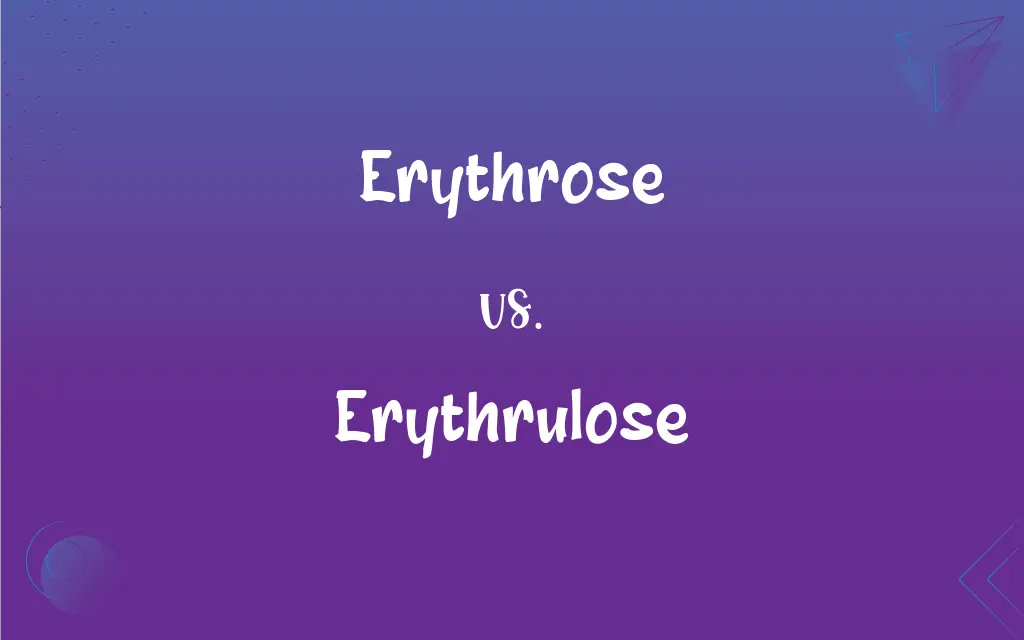Erythrose vs. Erythrulose: What's the Difference?
Edited by Aimie Carlson || By Janet White || Published on February 27, 2024
Erythrose is a four-carbon sugar, important in biochemical pathways, while erythrulose is a four-carbon keto-sugar used in self-tanning products.

Key Differences
Erythrose is a tetraose, the simplest type of aldose, and plays a role in the pentose phosphate pathway, a metabolic process. In contrast, erythrulose, a tetrose ketose, is known for its use in cosmetics, particularly in self-tanning products, due to its reaction with skin proteins.
Structurally, erythrose is an aldose sugar, meaning it contains an aldehyde group. Erythrulose, on the other hand, is classified as a keto-sugar, possessing a ketone group. This structural difference significantly alters their chemical properties and biological roles.
In biochemistry, erythrose is a precursor in the synthesis of amino acids. Conversely, erythrulose's primary commercial application is not in biochemistry but in the beauty industry, where it’s valued for its non-toxic, skin-coloring properties.
Erythrose is part of the Calvin cycle in photosynthesis, contributing to the synthesis of glucose in plants. Erythrulose, however, is synthesized industrially and is not a significant component of natural biological processes like photosynthesis.
The presence of erythrose is critical in cellular metabolism, particularly in plants and microorganisms. Erythrulose, despite being less prominent in natural biochemical pathways, has gained importance due to its dermatological applications.
ADVERTISEMENT
Comparison Chart
Type of Sugar
Aldose (contains an aldehyde group)
Ketose (contains a ketone group)
Role in Biochemical Pathways
Involved in pentose phosphate pathway
Not involved in major natural biochemical pathways
Industrial Application
Limited commercial use
Widely used in self-tanning products
Presence in Nature
Found in plants and some microorganisms
Synthesized industrially
Function
Part of amino acid synthesis and photosynthesis
Used for cosmetic skin coloring
ADVERTISEMENT
Erythrose and Erythrulose Definitions
Erythrose
A component in biochemical pathways.
Erythrose plays a role in the pentose phosphate pathway.
Erythrulose
A four-carbon keto-sugar.
Erythrulose is commonly used in self-tanning lotions.
Erythrose
A building block for amino acids.
In certain metabolic processes, erythrose is a precursor for amino acids.
Erythrulose
A tetrose used in self-tanners.
Erythrulose provides a natural-looking tan when applied topically.
Erythrose
A simple sugar involved in metabolism.
Erythrose is utilized in the metabolic pathways of microorganisms.
Erythrulose
A synthetic sugar for skin coloring.
Erythrulose is valued in the beauty industry for its safe tanning effects.
Erythrose
A tetraose sugar in plants.
Erythrose is found as part of the photosynthesis process in plants.
Erythrulose
An ingredient in cosmetic products.
Erythrulose reacts with proteins in the skin to give a tanned appearance.
Erythrose
A four-carbon aldose sugar.
Erythrose is an intermediate in the Calvin cycle of photosynthesis.
Erythrulose
A non-toxic sugar for dermatological use.
Erythrulose is preferred for its non-toxic nature in skin care formulations.
Erythrose
(carbohydrate) the aldotetrose (2R,3R)-2,3,4-trihydroxybutanal
Erythrulose
(carbohydrate) The ketotetrose (R)-1,3,4-trihydroxybutan-2-one used in some artificial tanning preparations
FAQs
What is erythrulose?
A four-carbon keto-sugar used in self-tanning products.
What is the primary use of erythrulose?
In cosmetic self-tanning products.
What is erythrose?
A four-carbon aldose sugar important in metabolism.
Is erythrose involved in photosynthesis?
Yes, as part of the Calvin cycle.
Can erythrose be used in food?
It's not commonly used in food industry.
Does erythrulose provide a permanent tan?
No, the tanning effect is temporary.
What makes erythrose important in biochemistry?
Its role in amino acid synthesis and metabolic pathways.
Where is erythrose found naturally?
In plants and some microorganisms.
Is erythrulose naturally occurring?
It is mostly synthesized industrially.
Is erythrulose safe for skin?
Yes, it's considered safe and non-toxic.
Is erythrose a simple sugar?
Yes, it's a simple tetraose sugar.
Is erythrose used in medicine?
Its use is primarily in biochemical research, not directly in medicine.
How is erythrulose applied in the beauty industry?
As an ingredient in self-tanning lotions.
Does erythrose have any industrial applications?
Limited, mostly in biochemical research.
Can erythrulose cause skin irritation?
Generally, it's well-tolerated but can vary with individual sensitivity.
How long does erythrulose's tanning effect last?
Typically a few days, depending on the formulation.
Does erythrose play a role in human metabolism?
Indirectly, in certain biochemical pathways.
Can erythrulose be used in combination with other tanning agents?
Yes, often combined with dihydroxyacetone (DHA).
Are there any dietary sources of erythrose?
Not significantly, as it's a metabolic intermediate.
What distinguishes erythrulose from other tanning products?
Its natural-looking tan and non-toxic nature.
About Author
Written by
Janet WhiteJanet White has been an esteemed writer and blogger for Difference Wiki. Holding a Master's degree in Science and Medical Journalism from the prestigious Boston University, she has consistently demonstrated her expertise and passion for her field. When she's not immersed in her work, Janet relishes her time exercising, delving into a good book, and cherishing moments with friends and family.
Edited by
Aimie CarlsonAimie Carlson, holding a master's degree in English literature, is a fervent English language enthusiast. She lends her writing talents to Difference Wiki, a prominent website that specializes in comparisons, offering readers insightful analyses that both captivate and inform.































































